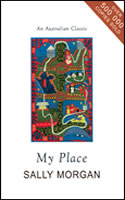Sally Morgan was born in Perth, Western Australia, in 1951 and grew up in suburban Manning. She completed a Bachelor of Arts degree at The University of Western Australia in 1974, majoring in Psychology. She also has post-graduate diplomas from the Western Australian Institute of Technology (now Curtin University of Technology) in both Counselling Psychology and Computing and Library Studies. She has three children.
My Place
Over 600,000 copies sold

This is a story of extended family, the treatment of Aboriginals, and history lost and found. Nan, the author's grandmother, wants to "forget" about her heritage. She teaches her grandchildren about birds and bullfrogs to make sure they know nature's side of life and instils in them a certain distrust of white people, but she won't talk about her past.
Late in his life, great-Uncle Arthur is eager to tell of his past, the fair and the unfair, even though it makes his sister Nan angry, for his stories bring forth painful memories she buried long ago.
Gladys, the author's optimistic mother, has allowed her past to fade from her consciousness: with a sick husband and four children she has plenty of other things on her mind.
And finally there is the author, Sally Morgan, who was told her family was from India and didn't realise for years that they were Aboriginal Australians. Although the autobiography centres upon the author's early life, it is the stories of her mother, great-uncle, and especially her grandmother that make this a moving book. When Sally Morgan's mother and grandmother allow themselves to remember their pasts, they affirm the power of the mind and the spirit.
My Place is a deeply moving account of a search for truth, into which a whole family is gradually drawn…







